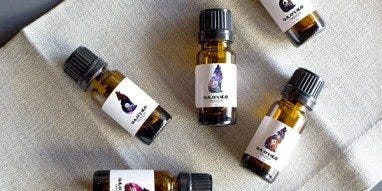Compost in a Bottle
https://pixabay.com/en/fresh-compost-hand-man-2386786/
You might think that the only place to make compost is outside in a big bin. While you won't be able to make a big amount of compost, you can also make compost out of organic materials in a couple of empty plastic bottles. This can be a great way to learn how compost forms out of eggshells, coffee grounds, and newspaper clippings. Once you see how easy it is to make compost, you might then try making a larger amount outside.
Micro-composters are small, just consisting of soda bottles that you cut apart and fill. After you cut and fill them, you fit them back together and tape them tightly. You will need to punch holes in the soda bottles so the contents inside can aerate, or get air. It's also necessary to insulate the bottles to keep the organic materials inside at the correct temperature.
Two-Bottle Bio-Reactor
A two-bottle bio-reactor involves two soda bottles. To make the bio-reactor, cut off one bottle just under the neck. Cut the other bottle about one inch lower so you can slip one bottle over the other with them overlapping slightly. You won't use the pieces you cut off, so you can throw them away.
- Making the aeration system involves creating an area at the bottom of the bottle that is open to the outside air. You then separate this space from the material you're composting. An easy way to do this is by positioning a Styrofoam disk that's supported at the bottom of the bottle. You can make the support out of a smaller bottle cut into two pieces crosswise about one inch from the bottom of the bottle. Make sure the smaller bottle is smaller in diameter than the big bottle for adequate air flow. Place the rim side pointing down, and place the Styrofoam disk on top of it. The material to be composted will sit on the disk, and the space underneath will create aeration for air flow.
- Make marks where the Styrofoam disk sits inside the bottle, then take it and its support out of the bottle. Use a nail (with a parent's help) to poke holes in the disk and the bottle's sides under the marks. Put the support and disk back in the bottle so you can fill it with material to compost.
- Fill the bottle loosely with equal parts of bulking agents and food for microbes. The materials should be damp but not soaking wet. Bulking agents can include wood chips and shavings, pieces of egg cartons, straw, or strips of newspaper. Food for the microbes can include carrot peels, lettuce scraps, apple cores, banana peels, bread crumbs, and weeds. Try to cut your pieces of organic materials very fine so they turn to compost faster.
- Insert a long thermometer into the mouth of the bottle so the tip of the thermometer goes into the organic materials. You can then track temperature changes.
- Cover the bottle's mouth with netting or mesh. You could also place the whole bottle in a nylon stocking, tying it at the top.
- Wrap up the bottle in a small towel or blanket to keep it warm.
Expandable Micro-Composter
Another way to make a soda bottle composter is with two or three bottles or more. You won't need a Styrofoam disk or support for this type of composter.
- Cover the top of one of the bottles with mesh, securing it with a rubber band. Then, fit it down inside the body of a second bottle that you cut in half. The mesh will allow moisture to drain away from the organic materials. You will provide aeration by poking holes in the bottles. You can cap the upper bottle to create a two-bottle compost rig. You can also add more bottles to have enough room for more organic materials.
- Cut one bottle in half. The bottom of this bottle will form the base of the composter. The upper part will be the cap.
- Cut the very bottom off of a second bottle.
- Cover up the neck of the second bottle using a piece of mesh, and put a rubber band around it to hold it tight.
- Fit the neck of the bottle into the base until the two bottles overlap, and tape up the seam.
- Place the cap on the top bottle, but don't tape it. You will need to be able to take off the cap to fill your composter.
- Heat an embroidery needle and use it (with a parent's help) to poke holes randomly around the bottles for aeration.
- Fill the composter with organic materials.
Making compost in soda bottles won't produce the same type of compost you'd get if you were making compost in a bin outside. However, after a couple of months, you should get compost that doesn't look anything like the original ingredients you put in your bottles.
Additional Resources
- Compost in a Bottle (PDF)
- Soda Bottle Composter (PDF)
- Making Compost (PDF)
- Break it Down: The Compost Connection (PDF)
- Composting With 4-H Clubs
- Composting With a Wiggle (PDF)
- Leaf it in Your Yard
- Food Waste Composting
- Make a Composter
- Building a Soda Bottle Bioreactor
- Compost: Your Trash, Nature's Treasure
- Composting: Nature's Disappearing Act
- Backyard Composting
- Introduction to Soil and Compost (PDF)
- Waste, Recycling, and Compost (PDF)
- Make a Worm Composting Bin
- Practice Good Environmental Stewardship (PDF)
- Making Compost in Schools (PDF)
- Compost: A Scientific Investigation
- Composting Goes to School (PDF)









